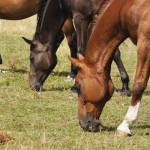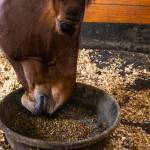Horse Pasture Management: A Year-Round Job

With spring fast approaching in many areas of the world, horse owners are looking forward to the sight of their equines running across lush fields and munching their way through bright green grass. While there’s still a little cold weather left, it’s time to think about keeping pastures in top condition.
Having pasture soil analyzed is the first step. This procedure is inexpensive and easy, and will tell you what nutrients your particular soil needs. Check with the local agricultural extension agent for instructions on collecting samples, which should be taken from several locations in each grazing area. If liming or fertilizing is recommended, schedule this well ahead of time because farm centers will quickly fill their equipment rental calendars as spring begins. Resist the urge to overfertilize; you’ll save some money and avoid having the excess fertilizer wash into streams and ponds.
Seeding should be done before established plants begin to grow, blocking access to bare soil. If thick forage remains from last season’s growth, mow or graze the field before seeding. Make a plan for rotating fields after seeding so that the new growth will have a chance to become established before horses are turned out to graze. If you have only one turnout area, consider using temporary fencing to divide the field, renovating half at a time.
Some weeds provide a range of nutrients and are appetizing to horses. If your field is crowded with weeds, however, check with the agricultural agent about appropriate control measures. You want to base your horse’s diet on forage, and growing mostly weeds instead of grass and legumes is not the best use of your pasture. Mowing fields before weeds go to seed will also help to keep unwanted plants under control.
One of the most important pasture management practices is to avoid overgrazing your land. Except in areas with exceptional soil and a perfect climate, at least two or three acres of pasture should be provided for each horse. In many regions, more land is required. Overgrazing quickly degrades pasture quality, encouraging erosion and weed growth. If you keep more horses than your land will easily support, consider using a sacrifice area or drylot where the horses can be turned out with hay for part of each day. This practice can be followed even if sufficient pasture is available in the case of overweight horses that need to have grazing time restricted.








